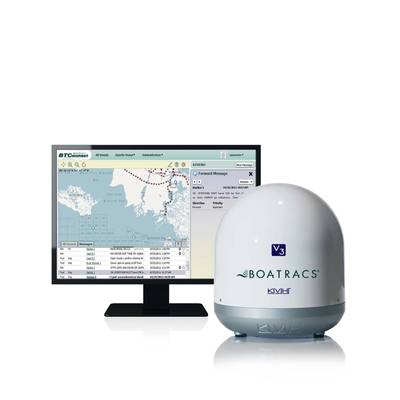Fleet Management & Operations Software – and Communications, too …
Connectivity and Communications Complete the Package.
The complex task of operating any marine enterprise isn’t getting any easier. Financial, regulatory, operational, environmental and human resource pressures all increase over time. In the brown water, workboat world, these problems are exacerbated by the sheer number of smaller operators struggling to catch up with business requirements that have become increasingly sophisticated, and over a very short period of time. Keeping track of the new subchapter “M” rules, for example, presents another headache, but that’s just one of many facing today’s operators.
Increasingly, like their bluewater cousins who have employed such tools for more than a decade, inland, workboat and OSV firms are turning to fleet management and operations software. Beyond the myriad software choices lurks the real issue for users of these management tools: selecting a viable and affordable communications vehicle to transmit data, back-and-forth. You really can’t mention one (software) without involving the other (communications). It also turns out that, like your own unique marine operation, no two solutions are exactly alike. This month, we catalogue just a few of these “combined” solutions. What we found out might just surprise you.
Cost-effective Instant Data Collection: Reducing Costs While Increasing Fuel Efficiency
Managing vessel fuel costs, due to the combination of escalating fuel prices and ship-sourced emissions regulations, is now a critical issue for operators. This trend continues into 2012 as the new regulations and “ECA’s” go into effect, requiring vessels to switch to more expensive lower-sulfur fuel in certain regions. That said; it is essential for maritime businesses to conduct ongoing assessments of each vessel’s fuel system to determine the steps necessary to operate according to regulations while running the ship effectively. This requires real-time monitoring of the vessel’s fuel storage, and the settling and service tank arrangement, as well as determining how to manage fuel switching when trading in areas where strict emission limits are in effect.
Kemilinks International Pte Ltd. works with customers to develop ways to facilitate cost-effective tracking, monitoring and telemetry communications between a customer’s onshore office and their assets at sea. The solution provider’s proprietary Fuel Monitoring System, which comes with a Microcontroller Unit fully embedded with software application to collect and analyze fuel and engine data is one way to counter the growing cost of navigating in international waters. The Fuel Monitoring System interfaces with any flow meter model and other sensors such as engines’ control panel, anemometer, GPS, etc., to capture data regarding engine RPM, engine load, propeller pitch, propeller load and rudder angle. This data can generate graphical trending reports that can be analyzed at the vessel’s corporate headquarters to determine ways to maximize efficiency.
In the early installations, the Fuel Monitoring System would send reports to a shared folder and the ship’s captain would email them at predetermined intervals back to the onshore office using satellite equipment that supported both broadband and voice services. But due to the airtime pricing structure of these satellite terminals, it was not cost-effective to send the fuel reports in near real-time. Customers wanted the fuel reports to arrive more frequently and automatically, without human intervention, allowing them to be able to analyze the operational efficiency of the vessel during a passage. However, they didn’t do this because sending multiple data files from sea using the satellite broadband terminals increases their operational expenses.
As Kemilinks searched for a cost-effective way to manage transmission from international waters, SkyWave Mobile Communications, a global provider of communication services for machine-to-machine (M2M) applications, was introducing the IsatData Pro satellite service that enables remote management of fixed and mobile assets anywhere in the world.
IsatData Pro is designed for transmitting telemetry information and remote management and control of equipment. It offers a significant increase in payload capacity compared to other satellite-based M2M services currently in the market, delivering up to 10,000 bytes of information to the device and up to 6,400 bytes from the device. In comparison, other global M2M satellite services currently available offer data connectivity at between 270 and 340 bytes.
By delivering large messages, IsatData Pro meets the increasing demand for more detailed information in M2M applications. The Fuel Monitoring System continually collects data and sends the information back to the Kemilinks hub at predetermined intervals. Using IsatData Pro, the Fuel Monitoring System automatically sends reports without any human intervention. The onshore office can also perform on-demand polls to extract “at the moment” data.
One of the principal competitive advantages of the IsatData Pro service is that it offers a flexible airtime usage plan. A company can subscribe to the new low data rate service to manage and communicate with more than one remote asset around the world. Another advantage is that since hardware and airtime plans for IsatData Pro are significantly lower than those for satellite broadband terminals, smaller vessels that typically would not have onboard internet or voice capability can now have access to Kemilinks’ fuel monitoring service. And lastly, for owners of maritime vessel fleets, satellite airtime can be pooled between vessels to reduce overall airtime costs. www.skywave.com
Blue Sky Network Brings Fleet Management to the Cloud with SkyRouter
Blue Sky Network recently announced the launch of New SkyRouter, a fleet management portal for marine applications. New SkyRouter is a feature rich, cloud-based solution designed to support connectivity with remotely dispersed mobile assets including Blue Sky Network’s advanced Dual Mode GSM and Iridium tracking and communication hardware. This solution enables seamless connectivity with assets in problematic cellular reception areas and in remote locations. SkyRouter requires no installation or purchase of specialized hardware or software.
Today’s fleet managers require around-the-clock communication and overall safety and fleet efficiency can be achieved through alerts, monitoring of position data, and unique event reporting. New SkyRouter leverages the integration of Blue Sky Network’s industry leading HawkEye 5300 which exploits the benefits of Iridium Satellite and GSM cellular tracking capabilities to deliver dual-mode tracking and event reporting of assets located anywhere in the world. Now fleet managers can receive real-time updates which including GPS location information, messages, and on board diagnostic (OBDII) alerts, among others.
Working in combination with Blue Sky Network’s robust certified hardware, SkyRouter can be easily installed on marine assets. Features include over-the-air parameter settings, automated event reporting, and local sensor data capture, and two-way messaging capability.
Jon Gilbert, CEO and Founder of Blue Sky Network told MarineNews in June, “This new platform in concert with our superb products means more mobile asset sectors can benefit from smooth integration of tracking hardware with a cloud based portal for seamless command and control across multiple asset types and deployments.” www.blueskynetwork.com
Broadband Fleet Management: The Boatracs and KVH Solution
Fleet management software can be a game-changing tool for maritime companies to compete more effectively and run their operations more efficiently, ultimately resulting in greater profitability. According to Boatracs, the critical driver of any software solution is capturing and accessing good data. In the marine world, this means how vessels and shore side operations communicate – both the software that is used as well as the network that is used to transmit the information.
For Boatracs, customer requirements can vary dramatically. Some of the factors that go into building a solution for our customers include fleet size, geographic areas of operation, the presence of an on board PC, and the type and amount of information required to be shared between the vessel and shore-side operations. The Boatracs approach, therefore, has always been to fit the solution to the customer’s needs as opposed to asking a company to change the way they do business.
Since 1990, Boatracs has provided a narrowband satellite solution with shore side fleet management software to enable vessels to communicate consistently with operations. This system, Boatracs OmniTRACS, meets the needs of those companies who have minimum data sharing needs and require simplicity and ease of use in an extremely affordable satellite solution. The fleet management software can be accessed from any PC or mobile device with internet connectivity. For those customers who operate within cellular coverage but require greater coverage and reliability, the recently developed and economical OmniTRACS solution makes transmitting the data as cost effective as possible.
The OmniTRACS solution currently serves thousands of vessels across North America, but the number of customers with requirements for uninterrupted internet connectivity and high-speed data transmission is growing. More vessels have PCs on board utilizing a variety of software applications, and satellite broadband has become a viable option due to a steady decrease in airtime rates combined with a decrease in the size of antennas.
Responding to the market, Boatracs recently announced a partnership with KVH to offer the industry a Broadband Fleet Management Solution. The Boatracs Broadband Fleet Management Solution is a unique end-to-end combination of fleet management software with mini-VSAT broadband connectivity to make data collection and transmission smooth, easy and affordable. The solution combines Internet and Voice over IP with vessel tracking, two-way messaging and custom forms to satisfy the needs of customers, crew and operations in one complete package. Components include Boatracs BTConnect, a web-based fleet management software that pulls data in from any vessel hardware to display positions and messaging on one integrated user interface , Boatracs BTForms, a custom smart forms software that converts the paper forms crew and operations are adept at using into dynamic forms that standardize data transfer and
TracPhone V3, the smallest maritime VSAT antenna that uses the reliable KVH global mini-VSAT Broadband service with data plans 1/10th the cost of comparable alternatives. www.baotracs.com
Marine CFO: Fleet Operations & Financials with an Agnostic Approach to Data Comms
Embracing a full Enterprise resource planning (ERP) approach, MarineCFO’s products encompass fleet operations and financials, and accounting, too. Dean Shoultz, MarineCFO’s Chief Technology Officer describes it simply, as “a holistic approach – our software touches every aspect of the business.” Shoultz adds that a key strength of MarineCFO’s turnkey solution is its flexibility and adaptability to existing client systems. And, MarineCFO provides a flexible architecture allowing companies to describe the business rules, workflows and alerts required to manage and conform to internal or external regulations, such as the USCG 46 CFR Subchapter “M” regulations.
For clients who don’t want the financials (60 percent run the full suite), MarineCFO comes with pre-built adapters for Oracle, SAP, the Microsoft suite, and most of the top tier and mid-market accounting systems. Shoultz adds, “Even the 40 percent who don’t use our financials derive tremendous benefits because we run our financials behind the scenes – capturing and organizing information in a way that is more suitable to be pushed over to whatever system they might have in play.”
With modules that range from the full gamut of marine operations to financials, human resources and fleet management, Shoultz also extols the virtues of the MarineCFO dashboard, which provides a WEB-based view of Key Performance indicators (KPI’s). Busy executives, therefore, don’t necessarily have to jump into the software; they can instead look at the web-based KPI’s.
The software’s framework provides for analysis of what makes each client unique. Shoultz explains, “There is no industry standard within the marine industry. There are common properties, but revenue models, determination of utilization rates and profitability all tend to be different.”
MarineCFO’s Vessel Operations Live! Suite resides on the vessel with a local database and no dependency on outside connection. Connectivity is then established through what Shoultz describes as a replication strategy. He explains, “This is highly configurable. Anything that be done on shore can also be done on the boat and that data is replicated, back and forth.”
It is on the matter of data communications, however, that Shoultz diverges with many competitors. “We’re provider agnostic – obviously, we prefer more bandwidth, but we’re configurable too. For example – if one portion of the fleet with use air cards, we can set things up differently than for SatCom transmittals, and we’ll set up with an eye towards knowing whether they are being charged by the data byte or in some other fashion. The consequence of having less bandwidth (or more expensive bandwidth) is deciding what data is absolutely critical to going back and forth, when and how. We can configure so that the customer has more control over their costs – what’s more economical and manageable. You analyze what you need it for and then decide – is it worth it to pay more for additional bandwidth?”
Beyond communications, MarineCFO provides even more choices. These include server-based (Enterprise type – behind the firewall) traditional software and a MarineCFO Live! true cloud-based application, oriented toward smaller operators who have similar billing and compliance challenges even if they only run one or two boats. The latter choice is designed to reach operators who typically can’t afford IT infrastructure and staff. Hosted on robust data servers, users pay a small monthly fee to access the application. Intentionally a little simpler, assuming that some firms have less sophisticated needs, the latter option is based upon the same framework. Nevertheless, some larger customers use portions of the cloud-based version because it makes for sense for them in certain instances. MarineCFO Live! is positioned as a turnkey product, with no IT investment required. Shoultz adds, “You give us a small check each month, and we’ll give you a system that works. Small operators like that. For Enterprise customers, we can mix the two solutions, to give them a more robust, versatile solution. They both write to the same data model.” www.MarineCFO.com
Different Boats; Different Longsplices
In ever-increasing numbers, Workboat operators who dip their toes into the operations and monitoring software game are quickly discovering that the software itself is only one part of the ultimate solution. Without a doubt, communicating that data – back-and-forth – is the final piece of the puzzle. Beyond this, and perhaps just as importantly, no one solution or combination thereof is right for every operator. That said, the solutions outlined in this article – and others, too – are a good place to start.
(Published in the July 2012 edition of MarineNews - www.marinelink.com)














